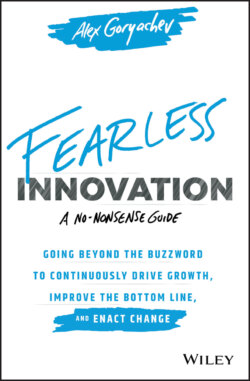Читать книгу Fearless Innovation - Alex Goryachev - Страница 15
Work with Change, Not Against It
ОглавлениеThe rate of acceleration in the Fourth Industrial Revolution cannot be stressed enough. Customer expectations are rapidly changing; businesses and organizations are suddenly evolving; new products and services are conquering industries practically overnight; and real-time hyper-collaboration across time zones, countries, and industries has become the norm. If we don’t accept and understand these influences, we’ll never be able to work with them, so it’s important to identify the key drivers that are enabling the world around us. These are, of course, subject to change at nearly any time, but there are a few mainstays that have proven their longevity and look to be integral going forward into the future as well.
First, the world is becoming truly digital. According to Cisco’s Visual Networking Index, by 2022 there will be so many connected devices in the world that they’ll number more than three times the global population. With 3.6 networked devices per capita, this adds up to an astonishing 28.5 billion networked devices, up from 18 billion only five years prior in 2017.26 Of course, all of these connected devices are contributing to the increase in global Internet traffic. Starting at only 100 gigabytes per day in 1992, in 2017 this traffic was up to 46,600 gigabytes per second and is expected to reach 150,700 gigabytes per second by 2022.27 In simple terms, here’s what happens in one minute on the Internet: 1 million people log in to Facebook, 4.5 million YouTube videos are viewed, 87,500 tweets are sent, 1.4 million pictures are swiped on Tinder, 3.8 million Google searches occur, and nearly $1 billion is spent on products and services.28
When looking at customer value, market valuation, and revenue growth rates, digital platforms are the most successful business models of our time, which include 70 percent of the top ten most valuable companies worldwide.29 As the world is becoming more connected, it’s been found that fewer than 10 percent of companies’ business models will be economically viable in such a climate—and private surveys show that CEOs know this.30
The second key driver of change is that technology is becoming radically more affordable, delivering greater capabilities while requiring less space. Take data storage, for example. As a student, I remember saving for months to buy a hard drive. Today, storage is nearly free, dropping from an estimated $500,000 per gigabyte to three cents per gigabyte, from around 1982 to 2017.31 There is a famous picture of an IBM 350 hard drive being loaded onto an airplane in 1956—the 5-megabyte hard drive weighed more than 2,000 pounds and was available at a rental price of a mere $3,200 per month. To put that in context, Apple’s most popular iPhone products 6 and 6 Plus, which sold over 130 million units, were priced at $200, weighed less than one-third of a pound, and had over 3,000 times the capacity of the IBM 350.
Thanks to technology, another major influence on how we live and work today comes from a changing economic landscape. There are significantly lower barriers to entering into almost any business than there were just a few decades ago. In today’s society, entrepreneurs can start their business and launch products or services seemingly instantaneously. Many no longer have to rent office space, buy assets, or even hire people, yet they can take their products global in no time.
These influences, coupled with an unprecedented access to capital, have given rise to all sorts of new businesses and ventures; from personal genomics and artificial intelligence to mobile food delivery and on-demand entertainment, we are provided with more opportunities to change our life experiences every single day. For example, now is the first time in human history that, in some countries, nearly anyone can take a convenient DNA test through the mail to check for potential diseases, hereditary traits, and family lineage, or simply in hopes of uncovering hidden family secrets.
Technological and scientific advances have also led to higher standards of living in many parts of the world as our needs continue to be met with greater efficiency and on a wider scale. Meeting our advancing human needs can be seen as a societal challenge, and societal challenges always lead to innovation. In return, innovation leads to solutions and even more change still, creating a constant cycle.
